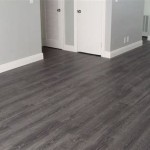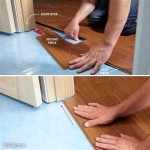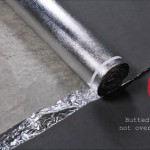Installing Laminate Flooring Around Stair Rails: A Comprehensive Guide
Laminate flooring offers a durable, aesthetically pleasing, and cost-effective alternative to hardwood, making it a popular choice for many homeowners. Installing laminate around stair rails, however, presents a unique set of challenges that require careful planning, precise execution, and the right tools. This article provides a detailed, step-by-step guide to successfully installing laminate flooring around stair rails, ensuring a professional and long-lasting finish.
The process involves more than simply laying laminate planks; it requires understanding the geometry of the stair rail supports (balusters, spindles, or newel posts), and how to accurately cut and fit the laminate around them. This ensures a seamless transition and prevents unsightly gaps or potential hazards. Proper preparation, accurate measurements, and the appropriate cutting techniques are crucial for achieving a polished and professional outcome.
This guide assumes a basic understanding of laminate flooring installation. Individuals unfamiliar with laminate flooring installation should consult introductory guides or seek professional assistance before attempting this project. The information presented here focuses specifically on the techniques required to navigate the obstacles presented by stair rails.
Key Considerations Before Beginning the Installation
Before commencing the installation, several critical factors must be considered to ensure a smooth and efficient process. Ignoring these preliminary steps can lead to frustration, wasted materials, and a less-than-satisfactory final result.
1. Accurate Measurement and Planning: The foundation of any successful flooring project lies in accurate measurements. Measure the entire flooring area meticulously, including the space around each stair rail. Create a detailed floor plan, noting the position of each rail and any other obstacles. This plan will serve as a guide for cutting and laying the laminate planks, minimizing waste and ensuring a proper fit. Consider the expansion gap required around the perimeter of the room and around each stair rail; this gap accommodates the natural expansion and contraction of the laminate due to changes in temperature and humidity.
2. Selecting the Right Tools: Utilizing the proper tools is essential for achieving precise cuts and a professional finish. Essential tools include a tape measure, a pencil, a safety square, a jigsaw, a hole saw (if required, depending on the rail design), a tapping block, a pull bar, and spacers. A miter saw can be beneficial for cutting laminate planks to length, but is not required for cutting around the rails specifically. Eye protection and a dust mask are crucial for safety. Investing in high-quality cutting tools will significantly improve the accuracy and ease of the installation process.
3. Preparing the Subfloor: A level and clean subfloor is critical for a successful laminate flooring installation. Ensure the subfloor is free of debris, nails, screws, and any unevenness. If the subfloor is concrete, check for moisture levels using a moisture meter. High moisture levels can damage the laminate flooring over time. If imperfections exist, use a self-leveling compound to create a smooth and even surface. Install an underlayment appropriate for laminate flooring. This underlayment provides cushioning, reduces noise transmission, and acts as a moisture barrier.
Cutting and Fitting Laminate Around Stair Rails: A Step-by-Step Approach
The most challenging aspect of installing laminate flooring around stair rails is accurately cutting the planks to fit snugly around the supports. This requires patience, precision, and a methodical approach.
1. Dry Fitting and Marking: Before permanently cutting any laminate plank, perform a dry fit. Place the plank in its intended position, ensuring it aligns with the adjacent planks and the stair rail. Use a pencil to mark the outline of the stair rail on the plank. Accuracy at this stage is paramount. Consider using a contour gauge to precisely transfer the shape of the rail to the plank, especially for irregularly shaped rails.
2. Precise Cutting Techniques: Depending on the shape and size of the stair rail, various cutting techniques may be required. For simple, straight-sided rails, a jigsaw can be used to carefully cut along the marked lines. For curved or irregularly shaped rails, a combination of techniques may be necessary. This might involve using a hole saw to create a circular opening, followed by a jigsaw to refine the shape. When using a jigsaw, use a fine-tooth blade designed for laminate flooring to minimize chipping and splintering. Cut slightly outside the marked line initially, then gradually trim the plank until it fits perfectly around the stair rail.
3. Utilizing Templates for Complex Shapes: For particularly complex rail designs, creating a template can be highly beneficial. Trace the outline of the rail onto a piece of cardboard or thin plywood. Carefully cut out the template and use it to transfer the shape onto the laminate plank. This technique allows for multiple attempts and adjustments, minimizing the risk of damaging the laminate flooring. The template can also be reused for multiple identical stair rails.
4. Addressing Expansion Gaps: Remember to account for the expansion gap around each stair rail. This gap is typically 1/4 to 3/8 of an inch and allows the laminate flooring to expand and contract without binding against the rail. Small pieces of laminate or spacers can be used to maintain the proper gap while the flooring is installed. This gap can later be filled with a flexible sealant or covered with a quarter-round molding for a finished appearance.
Finishing Touches and Long-Term Maintenance
Once the laminate flooring has been installed around the stair rails, a few finishing touches can elevate the overall appearance and ensure long-term durability. Proper maintenance will also help to preserve the beauty of the flooring for years to come.
1. Filling Gaps and Sealing: After the flooring is installed, inspect the gaps around the stair rails. If the gaps are too large or unsightly, fill them with a flexible sealant that matches the color of the laminate flooring. This will prevent dirt and debris from accumulating in the gaps and protect the edges of the laminate from moisture damage. Ensure the sealant is specifically designed for use with laminate flooring and that it remains flexible over time.
2. Installing Quarter-Round Molding (Optional): Quarter-round molding can be used to cover the expansion gaps around the stair rails and along the perimeter of the room, providing a clean and finished appearance. Choose a molding that complements the laminate flooring and carefully cut it to fit around the rails. Secure the molding with finishing nails or construction adhesive, ensuring it is properly aligned and flush with the flooring surface.
3. Regular Cleaning and Maintenance: To maintain the beauty and longevity of the laminate flooring, regular cleaning and maintenance are essential. Sweep or vacuum the floor regularly to remove dirt and debris. Use a damp mop with a laminate floor cleaner to clean the surface. Avoid using excessive water, as this can seep into the seams and damage the flooring. Place mats at entrances to trap dirt and moisture, and use furniture pads under heavy objects to prevent scratches. Promptly clean up spills to prevent staining.
4. Addressing Potential Problems: Over time, the laminate flooring may experience minor issues such as scratches or loose planks. Small scratches can often be repaired with a laminate repair kit. Loose planks can be reattached using laminate adhesive. For more serious damage, such as water damage or significant warping, replacement of the affected planks may be necessary. Regularly inspect the flooring for signs of damage and address any issues promptly to prevent further deterioration.
By following these detailed steps and paying close attention to detail, homeowners can successfully install laminate flooring around stair rails, achieving a professional and long-lasting result. Precise measurements, careful cutting techniques, and proper finishing touches are key to creating a seamless and aesthetically pleasing transition between the flooring and the stair rails. With proper maintenance, the laminate flooring will provide years of beauty and durability.

Fitting Flooring Around Stair Rail Spindles

Fitting Flooring Around Stair Rail Spindles

Fitting Flooring Around Stair Rail Spindles

Fitting Flooring Around Stair Rail Spindles

Install Laminate Flooring Around Stair Wood Banister Railing Baer Skirt Trim

Fitting Flooring Around Stair Rail Spindles
Laminate And Existing Banister Railing Diy Home Improvement Forum

How To Install Laminate Under Baers Spindles That Go In Ground

Fitting Flooring Around Stair Rail Spindles

Floating Floor In Couction With Baers Greenbuildingadvisor
Related Posts








